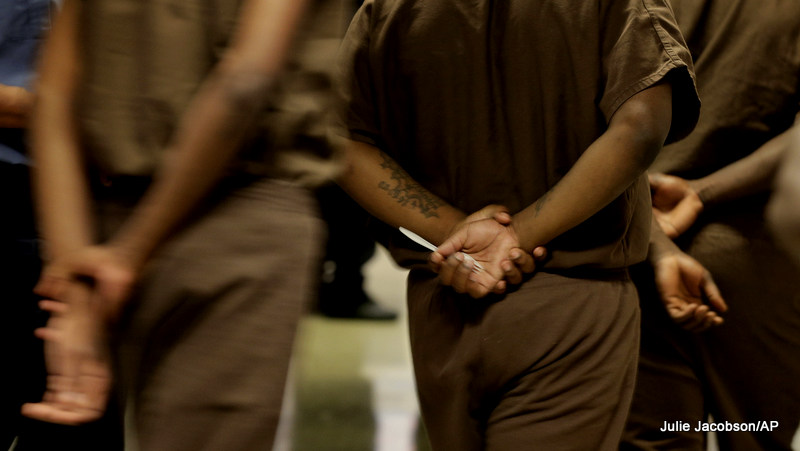
According to a 2011 study, at least a quarter of all Americans and as many as 41 percent of the population have been arrested at least once for an offense more serious than a traffic violation by the age of 23. While youth incarceration rates for the United States have been on the decline since 1995, the U.S. still holds the highest population of imprisoned children in the world.
At the same time, the use of private prisons in the American penal system has spiked. The “tough on crime” stance of the 1990s contributed to a 430 percent expansion of the general prison population from 1979 to 2009, according to Human Rights Watch.
The largest sector of this growth has been for nonviolent drug convictions. This has led to major overcrowding in many states, with California declaring its prison crowding situation a state of emergency. From 1999 to 2009, the inmate population in private prisons rose from 7,000 to 129,000, representing growth of 1,600 percent.
More than 50 percent of all youth correctional facilities are run by private operators, prompting concerns about the level of care that such a large segment of the youth population is receiving. In the last couple of years, reports of gross misconduct and abuse among private operators of juvenile detention centers have led many to reconsider the wisdom of sending juvenile offenders to private prisons.
PA Child Care LLC and Western PA Child Care, for example, were found to have offered kickbacks to two Luzerne County, Pennsylvania, judges in exchange for the judges sentencing 6,500 teenagers to incarceration in one of the for-profit youth prisons the companies run.
In another example, the Huffington Post discovered that detainees at youth facilities operated by Youth Services International “frequently faced beatings, neglect, sexual abuse and unsanitary food over the past two decades” — all while public officials knowingly turned a blind eye.
Many believe that the for-profit prison industry’s resurgence in recent years reflects increased lobbying efforts and a focus on providing housing services for immigration detainees. Some have argued that the private prison system has “gamed the system” through its lobbying and campaign donations toward improving its bottom-line.
In his study “The Color of Corporate Corrections,” African-American studies Ph.D. student Christopher Petrella found that the racial disparity in the private prisons of the nine states he examined were more severe than the public prison population in the same state.
Petrella concluded that private prisons were intentionally excluding individuals with high medical costs from their contracts. A young black inmate, for example, would have a lower medical need than an older white inmate, which would mean that the prison would get a greater return-on-investment with the young black prisoner.
CCA, the nation’s largest private prisons operator, pointed to this in the company’s 2010 Annual Report:
The demand for our facilities and services could be adversely affected by the relaxation of enforcement efforts, leniency in conviction or parole standards and sentencing practices or through the decriminalization of certain activities that are currently proscribed by our criminal laws. For instance, any changes with respect to drugs and controlled substances or illegal immigration could affect the number of persons arrested, convicted, and sentenced, thereby potentially reducing demand for correctional facilities to house them.
Currently, the vast majority of all drug arrests are against people of color. CCA spent more than $18 million in lobbying from 1999 to 2009.
While detention rates among all races have dropped since 2003, according to the Burns Institute, the incarceration disparity gap between whites and other racial groups have remained static or have increased. In 2011, for every white youth age 17 or younger in an American prison, there were five black youths (as compared to four in 2003), two Hispanic youths (same as 2003), three Native Americans (same) and 0.25 Asians (0.5 in 2003).
Among all juveniles sentenced to life without parole, for every one white life detainee, there are 10 black prisoners.
The argument presented by Petrella is difficult to refute, but it ignores early risk factors, such as family situation, childhood behavior and environment.
Roughly two-thirds of all teens that have been sentenced to time in a correctional facility have been diagnosed with a serious mental illness. From 2006 to 2010, per the Annie E. Casey Foundation, the number of American children living in areas of concentrated poverty rose nearly 25 percent, from 9 percent of the childhood populace to 11 percent. This means that a growing number of children are growing up food-insecure, unsure if their families will be able to pay the rent and heat, and without access to fresh foods, quality health care and adequate facilities.
“Every child needs a supportive environment to ensure his or her healthy growth and development,” read the Annie E. Casey’s Kids Count Data Snapshot on High-Poverty Communities. “However, research has shown that even when family income is held constant, families living in areas of concentrated poverty are more likely to struggle to meet their children’s basic material needs.”
“Children living in areas of concentrated poverty are also more likely to experience harmful levels of stress and severe behavioral and emotional problems than children overall.”

